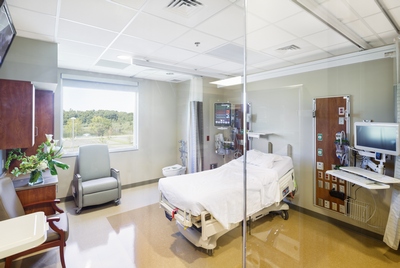Subscribe Now
Resuscitating ICUs to Increase Throughput and Improve Outcomes
 By Sheila J. Bosch
By Sheila J. Bosch
Patients are waiting to get in. Waiting in the emergency department, waiting in the post-anesthesia care unit, waiting in medical-surgical units and even waiting in other hospitals. Oftentimes it seems there just aren’t enough intensive care unit beds to meet the demand. Of course there are situations that beg for an ICU expansion, however, the problem of capacity constraint in the intensive care setting cannot necessarily be solved by constructing additional ICU rooms. Smart design, strategic layout and efficient processes can prevent ICU bottlenecks that contribute to care challenges, overcrowding and the postponement/cancellation of elective surgeries that can erode revenues and reduce patient satisfaction.
Right-sizing an ICU requires both qualitative and quantitative assessment, and determining future market and operational demand is a combination of both art and science. The most effective solutions typically involve a broad set of team members. By creating future market scenarios, the planning and design team frames the full range of potential inputs – population projections, utilization rates and market share – to form realistic, probable futures. But future market scenarios alone would only dictate the number of ICU beds that are needed under the current care delivery model. The planning and design process must be extended into the dynamics of the organization’s internal processes, the integration of technology and the performance of teams.
As an example, the Cincinnati Children’s Hospital Medical Center is utilizing computer models to anticipate the number of ICU beds needed for surgical patients. By limiting elective surgeries requiring ICU access, the associated patient flow improvements helped the hospital avoid $100 million in capital costs to create additional capacity.
It’s also of utmost importance to recognize that critical care patients have life-threatening illnesses or injuries and represent some of the most vulnerable patients in the hospital setting. While receiving treatment in a constrained setting, they require a team of specially trained healthcare professionals and specialized equipment. It is critical these patients be cared for in ICUs designed for optimal function and efficiency. Having a multidisciplinary team of clinical, administrative and design professionals working side by side will help ensure the physical environment in the ICU supports the provision of top-notch critical care.
Earlier this year, two publications on designing ICUs were released. The Center for Health Design published “Evidence Based Design Scan: Designing for the ICU” and Critical Care Medicine published “Guidelines for Intensive Care Unit Design,” with the intention of outlining best practices for designing critical care environments. Both articles emphasize the importance of designing for privacy, family accommodation and easy navigation. For example, in the recently completed Porter Regional Hospital in Valparaiso, Ind., the design team from Gresham, Smith and Partners consolidated the ICU from two floors to one floor for better function and flow. A large waiting room is also broken up into smaller spaces to allow for visitor privacy and serenity, and an adjacent coffee bar offers convenient access to refreshments.
By creating soothing environments with natural lighting (not only in patient rooms, but also in staff spaces) and positive distractions, designers may alleviate some of the tension often experienced in ICUs, while improving patient satisfaction. Efforts to improve patient visibility by the nursing staff are also important, as they support patient safety. Using a program such as UCL DepthMap, allows designers to quantitatively compare visibility of different layouts.
Right-sizing, efficient processes and healing environments are all essential to addressing ICU capacity constraints. With smart design and strategic layout, hospitals can increase throughput and improve patient outcomes, thus taking a major step forward on the road to long-term ICU success.
Sheila J. Bosch, Ph.D., EDAC, LEED AP, is director of healthcare research at Gresham, Smith and Partners. She can be reached at sheila_bosch@greshamsmith.com.
Tags:
Posted November 13, 2012
More Articles:
- Coverings 2024
Apr 22, 2024 – Apr 25, 2024 - Hospital, Outpatient Facilities & Medical Office Buildings Summit
Apr 25, 2024 – Apr 25, 2024 - CxA Workshop & Exam
Apr 29, 2024 – Apr 30, 2024 - EMP Seminar & Exam at CxEnergy 2024
Apr 29, 2024 – Apr 30, 2024 - CxEnergy
Apr 29, 2024 – May 2, 2024 - PHCC West 2024
Apr 29, 2024 – May 2, 2024 - Lean in Design Forum 2024
May 1, 2024 – May 2, 2024










